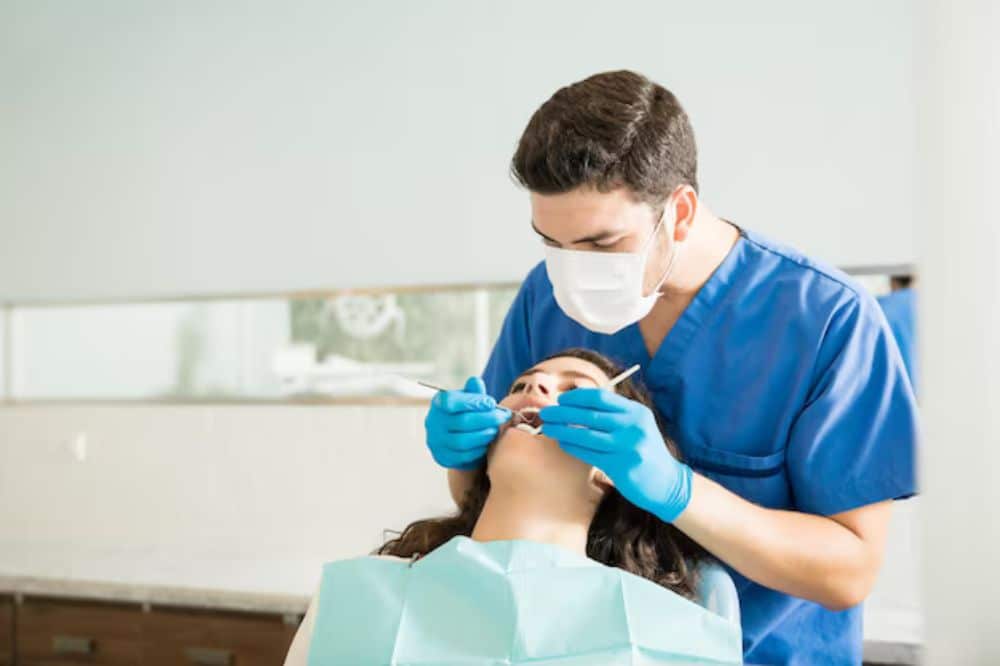Completing orthodontic treatment is a big milestone. Whether you’ve used traditional braces or Invisalign, you’ve dedicated time, patience, and care to creating a straighter, healthier smile. For many patients, orthodontics is the final step in their dental journey — but for others, it’s just one part of a bigger plan to restore both the appearance and function of their teeth.
One treatment that may be recommended after orthodontics is the placement of dental crowns. At Aria Dental Studio in Vancouver, we help patients understand when crowns might be the right choice and how they can protect and enhance a newly aligned smile.
In this article, we’ll explore what dental crowns are, why they’re sometimes recommended after orthodontic treatment, and how they can help maintain your results for years to come.
What Are Dental Crowns?
A dental crown is a custom-made cap that completely covers a tooth above the gumline. Crowns are made from strong, natural-looking materials such as porcelain, ceramic, or porcelain fused to metal. They are designed to restore a tooth’s shape, size, and strength while blending seamlessly with surrounding teeth.
Crowns are often used to:
- Protect weakened or damaged teeth
- Restore a tooth after root canal therapy
- Improve the appearance of misshapen or discoloured teeth
- Replace large fillings that no longer provide adequate support
When placed correctly, a crown can last for many years, providing durability and a natural aesthetic.
Why Dental Crowns May Be Needed After Orthodontics
Orthodontic treatment focuses on moving teeth into better positions for improved function and aesthetics. While this process can dramatically enhance your smile, it doesn’t fix every dental issue. In some cases, teeth may still need restorative work to function properly and look their best.
Here are some common reasons crowns are recommended after orthodontic treatment:
1. Restoring Worn or Damaged Teeth
Before orthodontics, teeth may have been chipped, cracked, or worn down due to grinding, injury, or years of misalignment. Even after alignment is corrected, these teeth may require additional strength and protection.
2. Protecting Teeth After Root Canal Therapy
If you’ve had a root canal in the past, the affected tooth can become more fragile. Placing a crown after orthodontics ensures it can handle daily chewing forces without risk of breaking.
3. Correcting Shape or Size Irregularities
Sometimes orthodontics aligns teeth perfectly, but one or more teeth are still uneven in size or shape. A crown can help create a balanced and symmetrical look, especially for front teeth.
4. Strengthening Teeth with Large Fillings
Large fillings can weaken tooth structure over time. Crowning these teeth after orthodontics helps prevent future fractures and preserves your investment in a healthy smile.
The Benefits of Crowns Post-Orthodontics
Choosing to get crowns after orthodontic treatment can offer both functional and cosmetic benefits:
- Durability: Crowns are strong and designed to withstand daily use, making them ideal for protecting vulnerable teeth.
- Aesthetic Appeal: High-quality crowns closely match the shade and translucency of your natural teeth.
- Long-Term Protection: They safeguard teeth that may be prone to damage or wear.
- Bite Stability: Crowns help maintain the precise bite achieved through orthodontics, preventing teeth from shifting.
When Should Crowns Be Placed?
Timing matters when it comes to placing dental crowns after orthodontics. In most cases, your dentist will wait until your braces or aligners are removed and your bite has stabilized. This ensures the crown fits perfectly in your newly aligned smile.
In situations where a tooth is severely damaged during orthodontic care, a temporary crown may be placed right away, with the permanent crown fitted after treatment is complete.
The Crown Placement Process
Getting a dental crown is a straightforward process that typically takes two appointments:
- Consultation and Assessment – Your dentist examines the tooth, takes X-rays if necessary, and discusses your options.
- Tooth Preparation – A small portion of enamel is removed to make space for the crown.
- Impression or Digital Scan – This ensures your crown will be a precise fit.
- Temporary Crown – Protects your tooth while the permanent crown is being made in a dental lab.
- Final Placement – The custom crown is bonded securely to the tooth, and adjustments are made for comfort and function.
Caring for Crowns After Orthodontics
A crown doesn’t require special maintenance, but good oral hygiene is essential for longevity. Here’s how to keep your crowned teeth — and your orthodontic results — in excellent condition:
- Brush twice daily with a fluoride toothpaste.
- Floss carefully around the crown to remove plaque and prevent gum inflammation.
- Avoid chewing hard foods like ice or hard candy that could chip the crown.
- Wear a nightguard if recommended, especially if you grind your teeth.
- Continue visiting your dentist regularly for checkups and cleanings.
Combining Cosmetic and Restorative Benefits
For some patients, crowns placed after orthodontics are purely functional, protecting teeth that have been weakened over time. For others, they are part of a cosmetic plan to create a perfectly even, bright smile.
In either case, crowns can complement the work done during orthodontics, ensuring that your smile is not only straight but also healthy, strong, and visually appealing.
Your Smile Is an Investment Worth Protecting
Completing orthodontic treatment is a major achievement, but it’s not always the final step. Adding a dental crown when recommended can protect your teeth, maintain your bite, and keep your smile looking beautiful for years.
At Aria Dental Studio, we work closely with our patients to determine the best post-orthodontic care for their individual needs. Whether you require one crown or multiple, our goal is to ensure the result is natural, comfortable, and long-lasting.
If you’ve completed orthodontic treatment and want to learn more about whether a crown is right for you, contact our team today. Book your appointment with a trusted Dentist in Downtown Vancouver and take the next step in protecting your new smile.



